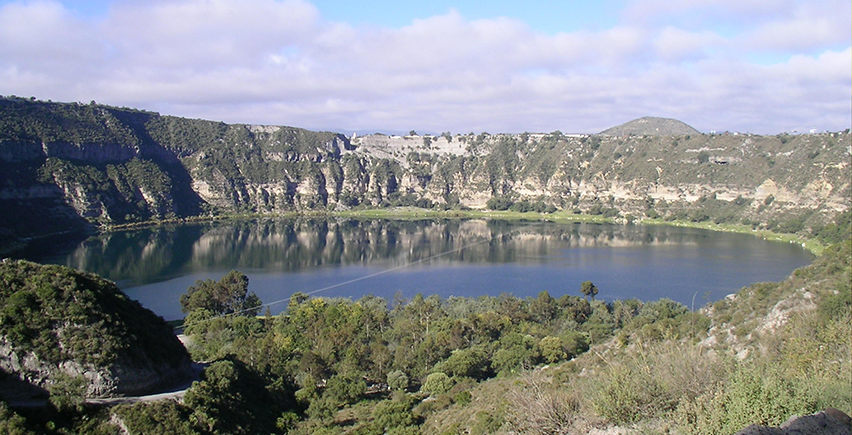29.01.2015: Why the mysterious Mesoamerican city of Cantona with 90,000 inhabitants was abandoned between 900 and 1050 A.D. might be a plot for the next Indiana-Jones movie. In fact, this question is the issue of a study of a group of American, German and Mexican scientist consisting of Geologists, Climatologists and Historians. The team around Tripty Bhattacharya at the University of California in Berkeley now found an interplay of climate change and political unrest to be the reason for the demise of this site of Precolombian culture in Mexico.
In a study just published in the Proceedings of the National Academy of Sciences the scientists show evidence for a strong regional climate change which must have strongly affected this society based on agriculture. Lake sediments from the nearby maar lake Aljojuca provided the paleolimnological evidence. Within the project “Tropical Climate Dynamics” hosted at the German Research Centre for Geosciences GFZ, sediment cores were retrieved and clearly showed how strong the environment had been affected. GFZ-Scientist Ulrike Kienel, one of the co-authors, comments: “We were able to deduce a climatology for the region that showed centennial-scale changes in rainfall. The ratios of the stable oxygen isotope of calcite precipitates clearly indicated increasing dryness during the period 500 to 1050 A.D.”. It was the period of increasing population of Cantona, which ended with the abandonment of the site as a response to a strong regional change in climate affecting the wellbeing of the people.
Tripti Bhattacharya et al.:”Cultural implications of late Holocene climate change in the Cuenca Oriental, Mexico”, Proceedings of the National Academy of Sciences (PNAS); published ahead of print January 26, 2015, doi:10.1073/pnas.1405653112
www.pnas.org/cgi/doi/10.1073/pnas.1405653112








![[Translate to English:] Torsten Sachs in front of a climate station on a field](/fileadmin/_processed_/3/9/csm__TorstenSachs_bearbeitet_GS_4a1365ef84.jpeg)

![[Translate to English:] left image flood at the Ahrtal: image from above, several houses are flooded; left image:: Heidi Kreibich;](/fileadmin/_processed_/4/4/csm_Bild2_9af0130e9f.png)



![[Translate to English:] Start der Vega Rakete](/fileadmin/_processed_/6/4/csm_20231201-kachel_Vega-VV23-launch_ESA-CNES-Arianespace_706716b68c.jpeg)









![[Translate to English:] Poster exhibition at the Brandenburg Hydrogen Day at the GFZ, some participants in the foreground](/fileadmin/_processed_/6/5/csm_Erster_Brandenburgischer_Wasserstofftag_GFZ_402fcec95e.jpeg)
![[Translate to English:] Group picture of the participants](/fileadmin/_processed_/9/4/csm_20231108_CAWa-Workshop-Tashkent_Gruppenbild_99ea779d8a.jpeg)

![[Translate to English:] [Translate to English:] Hörsaal](/fileadmin/_processed_/e/6/csm_H%C3%B6rsal_e21ac645fb.jpeg)


![[Translate to English:] The Delegations in the Historic Library on the Telegrafenberg. In the back there are from left to right, the Dutch Ambassador for Germany, Ronald van Roeden, the Dutch Minister for Education, Culture and Science, Robbert Dijkgraaf and the scientific director of the GFZ, Susanne Buiter.](/fileadmin/_processed_/d/b/csm_Kachel-2_9eba4b4212.jpeg)

